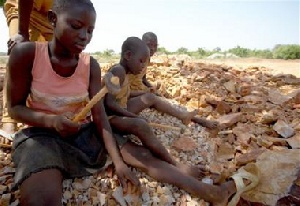The latest International Labour Organisation (ILO) estimates indicate that the number of child labourers has declined by one third since 2000 from 246 million to 168 million.
Also, the number of children in hazardous work currently stands at 85 million, down from 177 million.
Most of this was achieved in 2008 and 2012, when the global number fell by 47million, from 215 to 168 million, and the number of children in hazardous work fell by 30 million from 115 to 85 million.
Despite the progress, the 2016 target set by the international community for the elimination of Worst Forms of Child Labour, as priority within the global fight for eradication of all forms of child labour, will not be met.
“To have any chance of reaching that goal soon, we need to accelerate and intensify our efforts substantially," Deputy Minister of Employment and Labour Relations said on Thursday.
Speaking at the launch of the 2014 World Day against Child Labour in Accra, he noted that those who suffer due to poverty do not have the luxury, looking at the cause of the problem, and that, all they need is action.
The day which falls on June 12, is on the theme Combating Child Labour in Ghana through Effective Social Protection.
Mr Boasiko Sekyere said the issue of child labour was a matter of survival than looking into the future and noted that effective elimination of child labour requires policies that address persistent poverty and vulnerability of households to economic shocks.
He therefore, called on stakeholders to help nib the menace in the bud, and noted that the role of the media was critical in the move to progress. He said social protection helps to give all children an equal opportunity to fulfil their potential and live healthy, happy and productive lives.
The Minister of Gender, Children and Social Protection, Nana Oye Lithur, in her speech cited policy responses such as education, social protection and efforts to promote decent work for adults and the enforcement of regulations protecting the child.
According to her, government was committed to addressing the elimination of the menace and has been collaborating with stakeholders, including development partners and civil organisations in developing and implementing a number of interventions, such as prevention, withdrawal and rehabilitation support through building economic capacity of parents, as well as the sensitization of children on the dangers of child labour.
Also, interventions and legislations such as the Education Capitation Grant to make basic education accessible to children from poor household, the School feeding programme, free uniforms and exercise book programme, free National Health Insurance coverage for the extremely poor and vulnerable households and labour Intensive Public works, all geared towards human capital for sustainable growth and development.
This she said makes social protection a potent tool for addressing child labour.
Mr Affail Monney, President of Ghana Journalist Association said the causal factors of Child Labour were well known and that what was needed was effective action to tackle the issue from the branch and the root.
“The branch approach is encapsulated by the many workshop presentations, the copious public denunciation, and the litany of political promises to fix the issue. The root dimension calls for the implementation of pragmatic measures to provide more quality jobs, actualise the policy on free, compulsory and quality education for all children, as well as responsible parenthood.
He called on the media to sharpen their professional skills and amplify their advocacy voices against child labour in all its manifestations and more importantly remind, push and worry the political class, policy implementers and the NGO community to match their words with action.
Representatives from, the ILO, Ghana Employers Association and the Ghana Trade Union Congress called for the implementation of pragmatic policies to nib the menace in the bud.
Regional News of Saturday, 7 June 2014
Source: GNA













